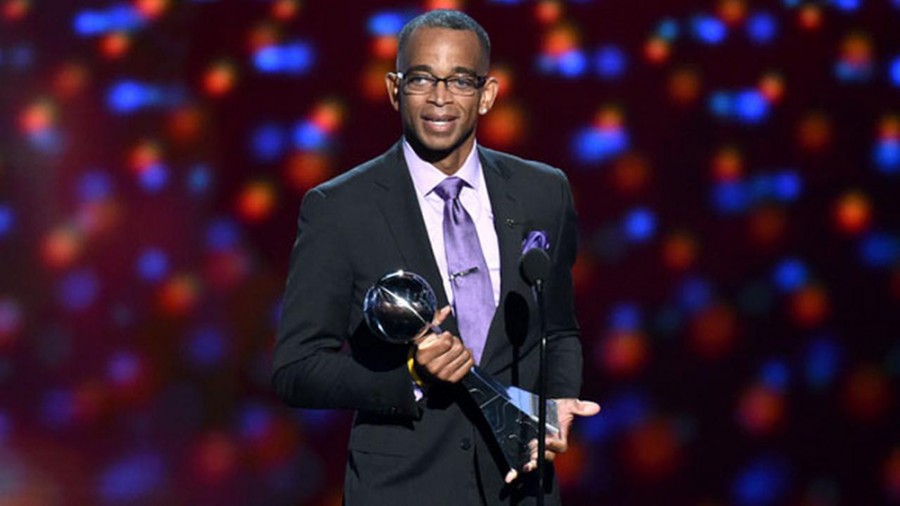STUART SCOTT: COOLER THAN THE OTHER SIDE OF THE PILLOW
January 6, 2015
Stuart Scott, longtime SportsCenter host and ESPN reporter, passed away Sunday, January 4, after a lengthy battle with cancer.
Scott was not only respected by his fellow sportscasters, but he was also viewed as a legend by millions of others who had the privilege of experiencing his quirky style of broadcasting. Beyond anything he accomplished in front of ESPN’s cameras, however, was his inspiring story.
Scott, a Chicago native, spent most of his years in North Carolina. He graduated from the University of North Carolina, and he soon found his way on to a local station. It didn’t take long for his exuberant style to be noticed by the big dogs in sports broadcasting, ESPN. “He was like a ball of fire walking in the door,” said ESPN senior vice president Mark Gross. “I had never met anybody like Stuart Scott.”
In fact, no one in America met anyone like Stuart Scott. And maybe America wasn’t ready. What may seem like commonplace in today’s sports broadcasting world, was once completely in contrast to all the rules of broadcast journalism. Scott’s inner-city, hip voice and vocabulary were met with resistance by the more conservative viewers. “He didn’t just push the envelope,” said former ESPN anchor Dan Patrick. “He bulldozed the envelope.”
Change is a specter. Change is the natural enemy of the way things are. And one thing is clear: most people like the way things are when it comes to their sports. However, Scott’s personality would not be contained, nor should it have been.
All of a sudden, the younger demographic thought it was cool to watch SportsCenter. How could they not? Up to that point, who else would have used terms such as “boo-yah,” “as cool as the other side of the pillow,” and “he must be butter, because he’s on a roll.” He never changed, and the haters soon had to realize that Scott was doing just fine. After all, this was a man who conducted interviews with Barack Obama, Bill Clinton, Tiger Woods, and Michael Jordan. What he was doing was working, and others could only mimic his style.
ESPN soon realized the gem that was working behind their desk, and they put him everywhere. From Monday Night Countdown, the MLB Playoffs, to the NBA Finals, Scott owned it; however, behind the personality that changed sports broadcasting forever was a disease that would soon change Scott’s life.
Scott was diagnosed with cancer in 2007. He eventually had all the necessary surgeries and treatments, but every time he believed he had beaten it, it would return in 2011 and 2013. All the while, Scott never gave up. His colleagues could not help but notice his extraordinary will, even when all seemed lost for the sportscaster who changed the game. “That’s what I love about him,” said ESPN anchor Suzy Kolber. “No matter how big he got, no matter how bad it got, he never changed. He loved his work, he loved his daughters, he loved being Stu.”
At the 2014 ESPYS, Scott received the Jimmy V Perseverance award for his unwavering commitment to his family and his passion during his ongoing battle with the terrible disease. For many, it was the first time seeing Stuart Scott the person, the father, the cancer patient; however, his speech was received just as well as any of his addicting sports highlights. “When you die, it does not mean that you lose to cancer,” Scott told the audience. “You beat cancer by how you live, why you live, and in the manner in which you live.” Scott closed his acceptance speech by asking his daughter Sydni to hug him on stage.
His ESPYS speech hit home for millions of people who tuned in, but it affected no one like the kids who grew up idolizing Scott. I know this because I was one of those wide-eyed kids who would wake up far too early in the mornings before school just to catch as much of the latest SportsCenter before eventually getting scolded for making everyone late. Every morning, Scott was there to make sure my morning routine was fulfilled.
I had never met the man once in my life, but he became my buddy. The same style that irritated the boring, old geezers back in the day became my inspiration. I would not be writing this on my school’s very own online paper if Stuart Scott was not there for me every single day when I was growing up. There will never be another like him, and anything else is just an impression.
He was as cool as the other side of the pillow. He was “Livin’ La Vida Loca.” He was a grown man wearing makeup who talked about sports. He won his battle.
Boo-yah, Stuart Scott.
